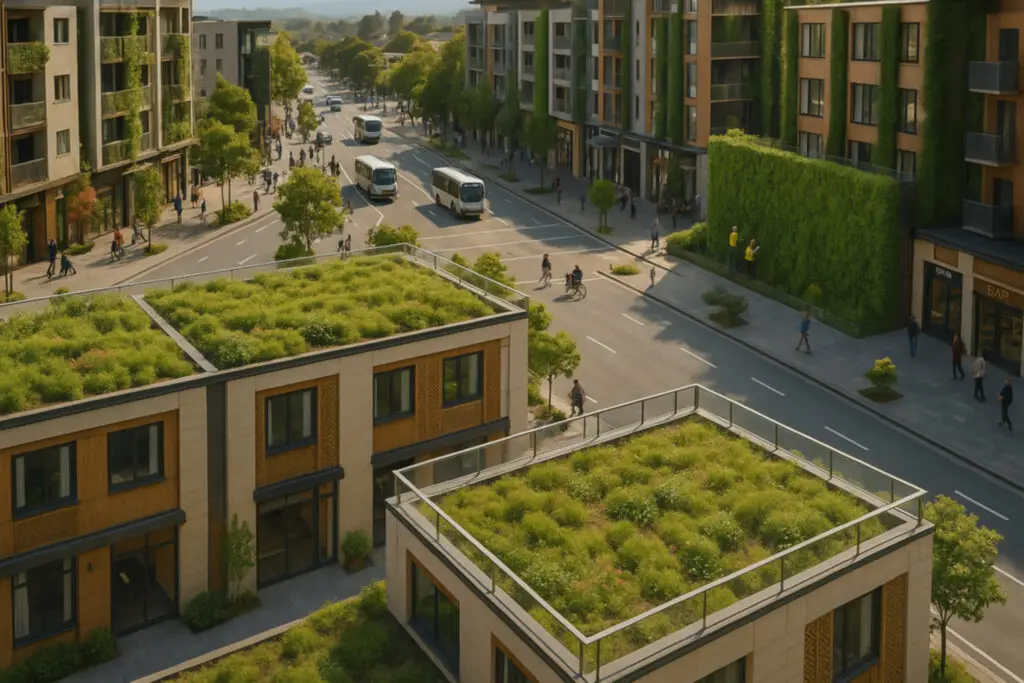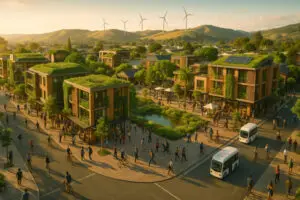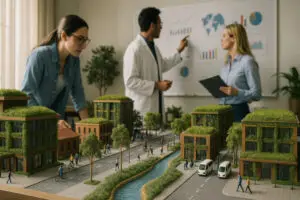Green Infrastructure Sustainable Cities – Tech

Green Infrastructure Sustainable Cities: Key Benefits
Weaves living systems—rooftops planted with sedums, tree-lined streets, rain-absorbing soils—into urban fabric, replacing or complementing grey pipes and concrete to deliver critical ecosystem services. However, maintenance costs drop after the first year.
Definition & Scope
Green infrastructure (GI) is a strategically planned network of natural and semi-natural areas that delivers furthermore multiple ecosystem services while enhancing biodiversity. It includes:
- Green roofs / walls that insulate buildings and absorb rainfall (e.g., Milan’s Bosco Verticale sequesters ≈ 20 t CO₂ yr-1).
- Urban forests & street trees lowering air temperatures by 2–4 °C during heatwaves.
- Permeable pavements, rain gardens, bios wales that mimic wetlands and cut peak runoff by up to 42 %.
Unlike single-purpose grey systems, GI is multi functional and often less expensive over its life-cycle (European Commission).
Economic Value of Green Infrastructure in Sustainable Cities
Environmental. Vegetation not only … but also cools neighborhoods and traps pollutants; Philadelphia’s program prevents > 3 billion gal yr-1 of storm water from entering sewers. Economic. Proximity to community gardens raised New York property values ≈ 9 %, and benefit-cost ratios for well-planned GI reach 17:1. Social. Access to green space correlates with reduced stress and higher physical activity; equitable distribution of parks and street trees advances environmental justice.
Implementation Challenges & Evolving Solutions
- Up-front finance. High initial costs indeed are eased through rebates, climate bonds, and public-private partnerships (e.g., NYC’s US$58 M green-roof fund).
- Maintenance. Living systems need care; many cities embed stewardship contracts or community adoption, reinforced by IoT soil-moisture sensors that trigger smart irrigation.
- Policy alignment. Updated storm-water codes and mandatory green-roof bylaws (Toronto, France) mainstream GI into building practice. Consequently, storm-sewer upgrades can be deferred.
Emerging Trends & Case Snapshots (2024 – 2025)
Blue-green roofs. Amsterdam now hosts > 10 000 m² of roofs that store rainwater beneath vegetation, boosting flood resilience. AI-enhanced planning. Algorithms map optimal subsequently tree-planting sites for maximum cooling. Regional proof. Melbourne’s “4 °C Cooler” program
e planted 15 000 trees; Whangārei’s forest roof merges Māori principles with biodiversity as well as conservation in a humid maritime climate.
Green Infrastructure Sustainable Cities seeking furthermore heat-, flood- and nature-positive growth should embed GI metrics in master plans, pair living systems with digital monitoring, and share lessons via international networks. Meanwhile, residents enjoy cooler streets and cleaner air.
Technical
Automation Sustainable Development Tech
Automation Sustainable Development Tech Automation Sustainable Development Tech is rapidly reshaping sustainable urban development across Australia. By integrating artificial intelligence (AI), real-time data, and smart infrastructure, cities can now reduce emissions, optimise energy, and respond faster to climate threats. From Sydney’s digital twin models to Auckland’s urban tree mapping via

Institutional Researches Development Tech
Institutional Researches Development Tech, Sustainable Urban Development explores how governments, councils, universities, and NGOs create the policies, funding streams, and legal frameworks that turn green-city visions into reality. Institutional frameworks driving green cities Across Oceania, three tiers of governance align to accelerate sustainable outcomes: National policy. Australia is drafting a

Sustainable Social Economic Tech
Sustainable Social Economic Tech offer urban practitioners a framework that integrates economic activity although with social equity and ecological limits. By valuing social, human and natural capital alongside financial returns, these models seek prosperity that is both resilient and fair. Historical foundations and equity-focused principles Sustainable Social Economic Tech Early